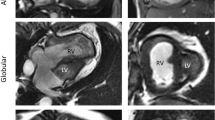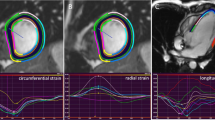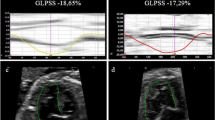Abstract
In hypoplastic left heart syndrome (HLHS), long-term outcome is closely related to right ventricular function. Echocardiography and magnetic resonance imaging (MRI) are routinely used for functional assessment. MRI 2D-tissue feature tracking (2D-FT) allows quantification of myocardial deformation but has not yet been applied to HLHS patients. We sought to investigate the feasibility of this technique and to compare the results to 2D-speckle tracking echocardiography (2D-STE). In routine MRI 2D anatomical four chamber view, cine images were recorded in 55 HLHS patients (median age 4.9 years [1.6, 17.0]). Regional and global peak systolic longitudinal strain (LS) and strain rate (LSR) were determined using 2D-FT software. Echocardiographic four chamber view was analyzed with 2D-STE. Visualization of all myocardial segments with MRI was excellent, regional, and global LS and LSR could be assessed in all data sets. In 2D-STE, 28% of apical segments could not be analyzed due to poor image quality. Agreement of 2D-FT MRI and 2D-STE was acceptable for global LS, but poor for global LSR. In MRI, regional LS was lower in the septal segments, while LSR was not different between the segments. GLS and GLSR correlated with ejection fraction (GLS: r = − 0.45 and r < 0.001, GLSR: r = − 0.34 and p = 0.01). With new post-processing options, the assessment of regional and global LS and LSR is feasible in routine MRI of HLHS patients. For LS, results were comparable with 2D-STE. The agreement was poor for LSR, which might relate to differences in temporal resolution between the two imaging modalities.





Similar content being viewed by others
References
Altmann K, Printz BF, Solowiejczky DE, Gersony WM, Quaegebeur J, Apfel HD (2000) Two-dimensional echocardiographic assessment of right ventricular function as a predictor of outcome in hypoplastic left heart syndrome. Am J Cardiol 86:964–968
Bell A, Bellsham-Revell HR, Beerbaum P, Razavi R, Greil G (2011) Inter-stage right ventricular remodeling in hypoplastic left heart syndrome. J Cardiovasc Magn Reson 13:P205
Feinstein JA, Benson DW, Dubin AM, Cohen MS, Maxey DM, Mahle WT et al (2012) Hypoplastic left heart syndrome: current considerations and expectations. J Am Coll Cardiol 59:42
Petko C, Uebing A, Furck A, Rickers C, Scheewe J, Kramer H-H (2011) Changes of right ventricular function and longitudinal deformation in children with hypoplastic left heart syndrome before and after the Norwood operation. J Am Soc Echocardiogr 24:1226–1232
Schlangen J, Petko C, Hansen JH, Michel M, Hart C, Uebing A et al (2014) Two-dimensional global longitudinal strain rate is a preload independent index of systemic right ventricular contractility in hypoplastic left heart syndrome patients after Fontan operation. Circ Cardiovasc Imaging 7:880–886
Khoo NS, Smallhorn JF, Kaneko S, Myers K, Kutty S, Tham EB (2011) Novel insights into RV adaptation and function in hypoplastic left heart syndrome between the first 2 stages of surgical palliation. JACC Cardiovasc Imaging 4:128–137
Michel M, Logoteta J, Entenmann A, Hansen JH, Voges I, Kramer H-H, Petko C (2016) Decline of systolic and diastolic 2D strain rate during follow-up of HLHS patients after Fontan palliation. Pediatr Cardiol 37:1250–1257
Voigt J-U, Pedrizzetti G, Lysyansky P, Marwick TH, Houle H, Baumann R et al (2015) Definitions for a common standard for 2D speckle tracking echocardiography: consensus document of the EACVI/ASE/industry task force to standardize deformation imaging. J Am Soc Echocardiogr 28:183–193
Hor KN, Gottliebson WM, Carson C, Wash E, Cnota J, Fleck R et al (2010) Comparison of magnetic resonance feature tracking for strain calculation with harmonic phase imaging analysis. JACC Cardiovasc Imaging 3:144–151
Ghelani SJ, Harrild DM, Gauvreau K, Geva T, Rathod RH (2016) Echocardiography and magnetic resonance imaging based strain analysis of functional single ventricles: a study of intra- and inter-modality reproducibility. Int J Cardiovasc Imaging 32:1113–1120
Schmidt R, Orwat S, Kempny A, Schuler P, Radke R, Kahr PC et al (2014) Value of speckle-tracking echocardiography and MRI-based feature tracking analysis in adult patients after Fontan-type palliation. Congenit Heart Dis 9:397–406
Pruessmann KP, Weiger M, Scheidegger MB, Boesiger P (1999) SENSE: sensitivity encoding for fast MRI. Magn Reson Med 42:952–962
Claus P, Omar AMS, Pedrizzetti G, Sengupta PP, Nagel E (2015) Tissue tracking technology for assessing cardiac mechanics: principles, normal values, and clinical applications. JACC Cardiovasc Imaging 8:1444–1460
Oxenham HC, Young AA, Cowan BR, Gentles TL, Occleshaw CJ, Fonseca CG et al (2003) Age-related changes in myocardial relaxation using three-dimensional tagged magnetic resonance imaging. J Cardiovasc Magn Reson 5:421–430
Neizel M, Lossnitzer D, Korosoglou G, Schaufele T, Lewien A, Steen H et al (2009) Strain-encoded (SENC) magnetic resonance imaging to evaluate regional heterogeneity of myocardial strain in healthy volunteers: comparison with conventional tagging. J Magn Reson Imaging 29:99–105
Mangion K, Clerfond G, McComb C, Carrick D, Rauhalammi SM, McClure J et al (2016) Myocardial strain in healthy adults across a broad age range as revealed by cardiac magnetic resonance imaging at 1.5 and 3.0T: associations of myocardial strain with myocardial region, age, and sex. J Magn Reson Imaging 44:1197–1205
Kempny A, Fernandez-Jimenez R, Orwat S, Schuler P, Bunck AC, Maintz D et al (2012) Quantification of biventricular myocardial function using cardiac magnetic resonance feature tracking, endocardial border delineation and echocardiographic speckle tracking in patients with repaired tetralogy of Fallot and healthy controls. J Cardiovasc Magn Reson 14:32
Anwar S, Harris MA, Whitehead KK, Keller MS, Goldmuntz E, Fogel MA, Mercer-Rosa L (2017) The impact of the right ventricular outflow tract patch on right ventricular strain in tetralogy of fallot: a comparison with valvar pulmonary stenosis utilizing cardiac magnetic resonance. Pediatr Cardiol 38:617–623
Heiberg J, Ringgaard S, Schmidt MR, Redington A, Hjortdal VE (2015) Structural and functional alterations of the right ventricle are common in adults operated for ventricular septal defect as toddlers. Eur Heart J Cardiovasc Imaging 16:483–489
Vo HQ, Marwick TH, Negishi K (2017) MRI-derived myocardial strain measures in normal subjects. JACC Cardiovasc Imaging 11:196–205
Tham EB, Smallhorn JF, Kaneko S, Valiani S, Myers KA, Colen TM et al (2014) Insights into the evolution of myocardial dysfunction in the functionally single right ventricle between staged palliations using speckle-tracking echocardiography. J Am Soc Echocardiogr 27:314–322
Moiduddin N, Texter KM, Zaidi AN, Hershenson JA, Stefaniak CA, Hayes J, Cua CL (2010) Two-dimensional speckle strain and dyssynchrony in single right ventricles versus normal right ventricles. J Am Soc Echocardiogr 23:673–679
Singh GK, Cupps B, Pasque M, Woodard PK, Holland MR, Ludomirsky A (2010) Accuracy and reproducibility of strain by speckle tracking in pediatric subjects with normal heart and single ventricular physiology: a two-dimensional speckle-tracking echocardiography and magnetic resonance imaging correlative study. J Am Soc Echocardiogr 23:1143–1152
Pedrizzetti G, Claus P, Kilner PJ, Nagel E (2016) Principles of cardiovascular magnetic resonance feature tracking and echocardiographic speckle tracking for informed clinical use. J Cardiovasc Magn Reson 18:51
Orwat S, Kempny A, Diller G-P, Bauerschmitz P, Bunck AC, Maintz D et al (2014) Cardiac magnetic resonance feature tracking: a novel method to assess myocardial strain. Comparison with echocardiographic speckle tracking in healthy volunteers and in patients with left ventricular hypertrophy. Kardiol Pol 72:363–371
Chow P-C, Liang X-C, Cheung EWY, Lam WWM, Cheung Y-F (2008) New two-dimensional global longitudinal strain and strain rate imaging for assessment of systemic right ventricular function. Heart 94:855–859
Smith BCF, Dobson G, Dawson D, Charalampopoulos A, Grapsa J, Nihoyannopoulos P (2014) Three-dimensional speckle tracking of the right ventricle: toward optimal quantification of right ventricular dysfunction in pulmonary hypertension. J Am Coll Cardiol 64:41–51
Almeida-Morais L, Pereira-da-Silva T, Branco L, Timoteo AT, Agapito A, de Sousa L et al. (2016) The value of right ventricular longitudinal strain in the evaluation of adult patients with repaired tetralogy of Fallot: a new tool for a contemporary challenge. Cardiol Young 2016:1–9
Levy PT, Sanchez Mejia AA, Machefsky A, Fowler S, Holland MR, Singh GK (2014) Normal ranges of right ventricular systolic and diastolic strain measures in children: a systematic review and meta-analysis. J Am Soc Echocardiogr 27:549
Lorch SM, Ludomirsky A, Singh GK (2008) Maturational and growth-related changes in left ventricular longitudinal strain and strain rate measured by two-dimensional speckle tracking echocardiography in healthy pediatric population. J Am Soc Echocardiogr 21:1207–1215
Lopez-Candales A, Dohi K, Bazaz R, Edelman K (2005) Relation of right ventricular free wall mechanical delay to right ventricular dysfunction as determined by tissue Doppler imaging. Am J Cardiol 96:602–606
Petko C, Hansen JH, Scheewe J, Rickers C, Kramer H-H (2012) Comparison of longitudinal myocardial deformation and dyssynchrony in children with left and right ventricular morphology after the Fontan operation using two-dimensional speckle tracking. Congenit Heart Dis 7:16–23
Petko C, Voges I, Schlangen J, Scheewe J, Kramer H-H, Uebing AS (2011) Comparison of right ventricular deformation and dyssynchrony in patients with different subtypes of hypoplastic left heart syndrome after Fontan surgery using two-dimensional speckle tracking. Cardiol Young 21:677–683
Maret E, Todt T, Brudin L, Nylander E, Swahn E, Ohlsson JL, Engvall JE (2009) Functional measurements based on feature tracking of cine magnetic resonance images identify left ventricular segments with myocardial scar. Cardiovasc Ultrasound 7:53
Acknowledgements
The authors thank Mrs. Traudel Hansen and Mrs. Gabriele Kroeger for their assistance in patient management, Dr. Marka-Jill Jussli-Melchers and Dr. Jens Groebner for clinical and technical comments.
Author information
Authors and Affiliations
Corresponding author
Ethics declarations
Conflict of interest
The authors declare that they have no conflict of interest.
Ethical Approval
The study was performed according to the protocol (No. AZ 168/07) approved by the institutional ethics committee and in accordance with the ethical standards laid down in the 1964 declaration of Helsinki and its later amendments.
Informed Consent
All parents or legal guardians gave their informed consent in a written form.
Rights and permissions
About this article
Cite this article
Salehi Ravesh, M., Rickers, C., Bannert, F. et al. Longitudinal Deformation of the Right Ventricle in Hypoplastic Left Heart Syndrome: A Comparative Study of 2D-Feature Tracking Magnetic Resonance Imaging and 2D-Speckle Tracking Echocardiography. Pediatr Cardiol 39, 1265–1275 (2018). https://doi.org/10.1007/s00246-018-1892-x
Received:
Accepted:
Published:
Issue Date:
DOI: https://doi.org/10.1007/s00246-018-1892-x




